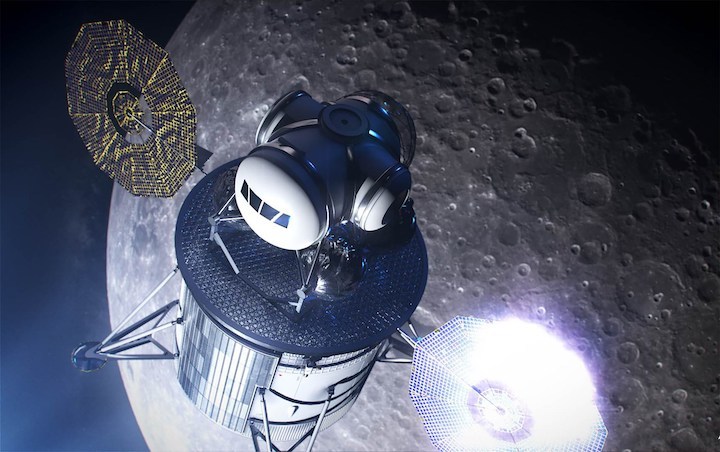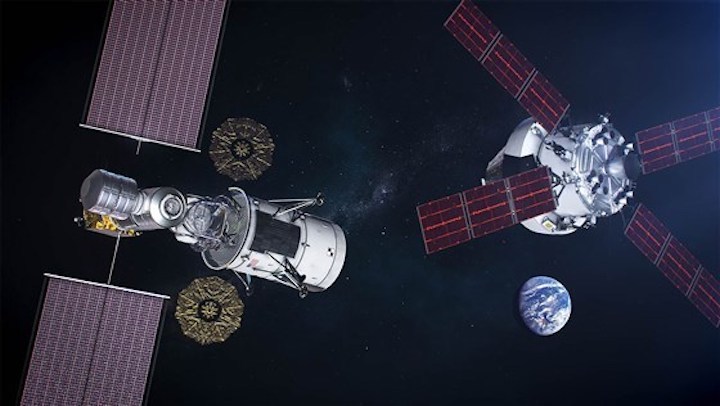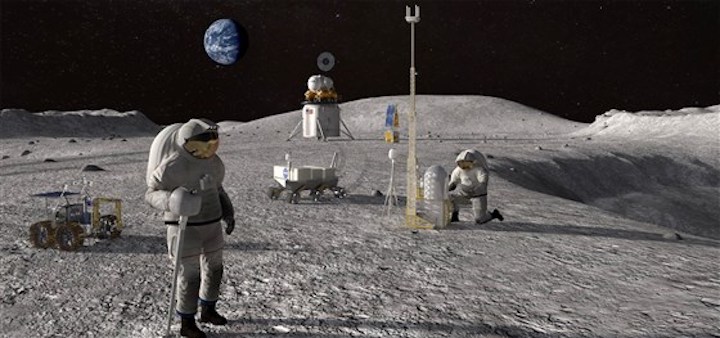11.06.2019

The Greek god who became the namesake of NASA's Apollo program in the 1960s and ’70s had a twin sister named Artemis, and NASA says she’ll lead humans back to the moon.
The Artemis program, unveiled by NASA in mid-May, aims to put astronauts on the lunar surface in 2024 — and give us the first female moonwalker. The initiative comes as the nation prepares to celebrate the 50th anniversary of the Apollo 11 landing in 1969, which made Neil Armstrong and Buzz Aldrin the first people to set foot on another world.
Preparations for Artemis have already begun, as NASA gets set for the maiden flight of its Space Launch System (SLS) rocket next year. The giant booster — it’s taller than a 30-story building — will blast a new crew capsule dubbed Orion on an uncrewed mission to the moon and back. That will be followed in 2022 by a test with up to four astronauts aboard and, after that, the construction of a small space station in orbit around the moon. NASA will dock a lunar lander there in 2024; that same year, four astronauts will fly in the Orion capsule to the station, board the lander and descend to the lunar surface.

It’s a bold plan — and success isn’t certain. Artemis faces a myriad of hurdles — political and budgetary, as well as technological. And then there’s the matter of getting it all done by 2024.
"As the Apollo program showed, humans have the ability to make great technical strides in a short period of time if everyone gets behind a mission," said Laura Seward Forczyk, founder of the Atlanta-based space consulting firm Astralytical. "However, I don’t think anyone would be surprised if NASA slipped the date by a few years."
The messy backstory
The last time humans left low Earth orbit was 1972, when the last Apollo astronauts returned from the moon. After that, political interest in sending humans into deep space waned, and funding for such missions dried up. So NASA turned to projects in Earth's orbit, notably the space shuttle and the International Space Station.
In the wake of the 2003 space shuttle Columbia disaster, President George W. Bush directed NASA to send humans back to the moon by 2020. But in 2009, a government panel determined the agency was so far behind schedule that moon landings would occur no sooner than the 2030s. The Obama administration axed the moon program altogether in 2010 and directed NASA to focus on missions to Mars.
So the agency began building the 322-foot-tall SLS rocket. SLS was supposed to fly in 2017, but technical snafus, contractor problems and a cost overrun of more than $6 billion have kept the big rocket on the launch pad. With the Mars program languishing, the Trump administration redirected NASA back to the moon in late 2017.
The agency responded with plans to get there by 2028 — not just to put boots on the ground, but to stay permanently. But Vice President Mike Pence, speaking last March in Huntsville, Alabama, said 2028 was "just not good enough." He ordered NASA to speed things up to 2024.
The result was Artemis: an all-out effort to land on the moon in 2024 while preserving plans to establish a permanent lunar base in 2028.
Shifting political winds
Pence's 2024 deadline raised eyebrows among some space experts, who suspect the date may have been picked for political reasons. The 2024 date would coincide with the end of a theoretical second term for President Donald Trump.
"That Trump believes he will derive political benefit from Artemis is a bit silly," said Matthew Hersch, an assistant professor in the history of science at Harvard University. "Public enthusiasm for a return to the moon has never been high, but Trump doesn’t live in a world of facts."

Trump himself has sent mixed signals to NASA about Artemis. Despite personally championing the program on multiple occasions, he seemingly withdrew his support in a June 7 tweet, saying NASA should focus on Mars, which remains the agency’s long-term goal.
One thing’s certain: NASA will need more money to get the job done. It recently asked the Trump administration for an additional $1.6 billion in extra funding for 2020. But only Congress can authorize those funds, and some legislators have voiced skepticism as the agency rushes to finalize a plan.
"While I can’t argue with the desire to invigorate our human exploration efforts and find near-term milestones to demonstrate success, the lack of planning evident so far, is no way to run our nation’s human space exploration program," Rep. Kendra Horn, D-Okla., said at a May 8 House hearing on NASA's ambitions.
Complicating matters is the possibility of another government shutdown. If no deal on spending is reached by Sept. 30, Congress might simply extend funding levels from 2019, which could mean no extra money for NASA.
And some say the proposed lunar space station, known as the Gateway, will only slow NASA on its rush to the lunar surface. Among its critics is former NASA administrator Michael Griffin, who last year called the Gateway a "stupid architecture."
Philip Metzger, a planetary scientist at the University of Central Florida, said NASA might be including the Gateway in Artemis as a form of “insurance” that could protect the plan from shifts in the political winds in Washington. After all, the space agency has seen its deep space plans change in each of the last three administrations.
"Consider what happens if the next election brings a different administration, and out of spite for the current administration the lunar program gets canceled and NASA is redirected back to Mars," he said. "If NASA managed to keep Gateway in their current lunar plans, then they will still have that to show for their efforts, and they can carry it into their new Mars plans."
A new approach
The lunar landers used in the Apollo missions were built by NASA contractors, but NASA plans to buy the landers to be used for Artemis from a private company to cut costs.
This summer, the agency will begin accepting design ideas from firms hoping to win the contract, which will likely include traditional aerospace firms like Lockheed Martin as well as SpaceX and Blue Origin, whose founder, Jeff Bezos, unveiled the company’s “Blue Moon” lunar lander at a splashy event in May.
NASA isn’t dictating the specifics of how the landers should work, hoping that allowing each company to explore its own ideas could help keep a lid on costs. Eric Stallmer, president of the Commercial Spaceflight Federation, a Washington-based group that represents the commercial spaceflight industry, said in a statement that the approach "prudently highlights commercial space capabilities as a central pillar of this strategy."
Nonetheless, it will be a tall order for the winning company to build its lander and ship it to the Gateway by 2024 — most likely in multiple pieces on separate rockets.
On the moon
When Armstrong and Aldrin landed on the moon in 1969, they spent just two and a half hours during their one and only moonwalk, deploying scientific experiments and collecting samples of the rocky lunar soil known as regolith. Similarly, the two Artemis astronauts who land on the moon in 2024 will likely spend less than a day before returning to the Gateway and then to Earth.
NASA has yet to say what the Artemis crew will do during their visit, but scientists already have ideas.
The landing will occur at the moon's south pole, a region not explored by any Apollo missions. Scientists suspect that part of the moon's inner crust may be exposed there, and that samples from this region might reveal clues about the formation of both the moon and the inner solar system, including Earth.
"The No. 1 science priority should be collecting rock and regolith samples and returning them to Earth," said Amy Fagan, an assistant professor of geosciences and natural resources at Western Carolina University in Cullowhee, North Carolina. "Imagine what new samples could bring from an unexplored site, particularly one that could shed light on the volatile story at the polar regions."
Though NASA is still finalizing the next phase of Artemis after the 2024 landing, preliminary plans show another surface mission each year through 2028, culminating with the deployment of a "lunar surface asset" — in other words, a moon base.
The lunar south pole is also an attractive spot because its permanently shadowed craters hold ice that could be mined to produce water and rocket fuel — essential resources for establishing a permanent outpost.
"I hope NASA focuses its lunar surface activities on developing space mining and manufacturing using lunar resources," Metzger said. "These are the technologies that need to be incubated most, for humanity’s future in space and for the U.S. to project presence and competence in space."
Quelle: NBC
